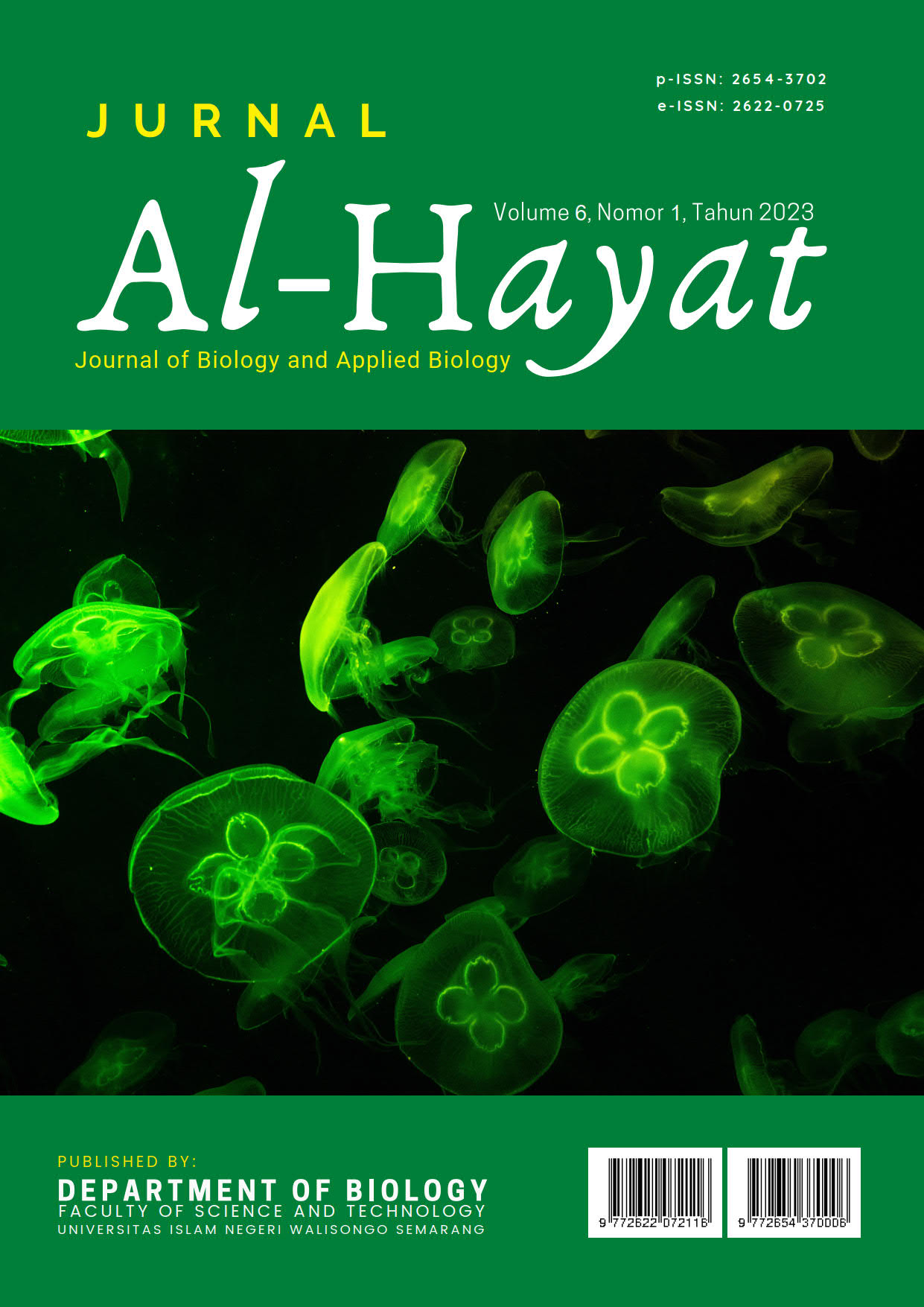The Potential of Indigenous Bacteria From Various Sample Soil in Degrading Polymer Plastic Waste
Main Article Content
Abstract
The accumulation of plastic waste is one of the main problems being faced by various countries in the world. The nature of plastic which is not easily degraded naturally will consequently be buried in the soil so that it will gradually change the soil components. Plastic belongs to a group of multifunctional complex polymers which have become conventional products in all sectors of life. The use of plastic on a large scale has an effect on increasing the amount of waste, such as the types of High Density Polyethylene (HDPE) and Low Density Polyethylene (LDPE) plastics. This study aims to obtain indigenous bacterial isolated from various soil samples in the landfill area and mangrove forests in Surabaya on the degree of degradation of HDPE and LDPE plastic polymers. Two places namely the final disposal site (TPA) and the Keputih bamboo forest in Surabaya. Sampling at landfill sites and mangrove forests. Then isolate the bacteria from soil samples and plastic waste obtained. Next, purification and screening of HDPE and LDPE polymer plastic degrading bacteria. The results of the isolation succeeded in obtaining 19 types of isolates that can grow on media containing plastic, with the majority having the characteristics of bacilli, Gram negative, catalase positive, capable/incapable of fermenting glucose and lactose and having cell sizes between 1-5 µm. Screening test results obtained that isolate 2 (K1D2U2 KPH) isolated from the Keputih Final Disposal Site (TPA) was identified as a Bacillus sp., with HDPE degradation ability of 27.13% and Isolate 17 (K2D3U1 MWJ) which was isolated from the Wonorejo mangrove forest was identified as a Pseudomonas sp. with LDPE degradation ability of 21.64%.
Keywords: Plastics, HDPE, LDPE, Pseudomonas sp. and Bacillus sp.
Downloads
Article Details

This work is licensed under a Creative Commons Attribution-ShareAlike 4.0 International License.
The copyright of the received article shall be assigned to the journal as the publisher of the journal. The intended copyright includes the right to publish the article in various forms (including reprints). The journal maintains the publishing rights to the published articles. Authors are allowed to use their articles for any legal purposes deemed necessary without written permission from the journal with an acknowledgment of initial publication to this journal.
The work under license Creative Commons Attribution-ShareAlike 4.0 International License.
References
Agustien, A., Jannah, M., & Djamaan, A. (2016). Screening Polyethylene Synthetic Plastic Degrading-Bacteria from Soil. Scholars Research Library Der Pharmacia Lettre, 8(7), 183–187. www.scholarsresearchlibrary.com
Arimurti, A. R. R., Rohmayani, V., Romadhon, N., Rahmani, T. P. D., Watson, L. J., Wahyuni, K. S., & Ulumiya, N. (2022). The potency of bacteria isolated from the hydroponic rockwool of field mustard (Brassica rapa L.) for nitrogen fixation and indole acetic acid (IAA) production. Biogenesis: Jurnal Ilmiah Biologi, 10(1). https://doi.org/10.24252/bio.v10i1.28451
Arora, P. K., Sharma, A., & Bae, H. (2015). Microbial degradation of indole and its derivatives. Journal of Chemistry, 2015(1), 1–13. https://doi.org/10.1155/2015/129159
Arutchelvi, J., Sudhakar, M., Arkatkar, A., Doble, M., Bhaduri, S., & Uppara, P. V. (2008). Biodegradation of polyethylene and polypropylene. Indian Journal of Biotechnology, 7(1), 9–22.
Aryal, S. (2022, August 10). Differences between Gram Positive and Gram Negative Bacteria. Https://Microbiologyinfo.Com/Differences-between-Gram-Positive-and-Gram-Negative-Bacteria/.
Asmita, K., Shubhamsingh, T., & Tejashree, S. (2015). Isolation of Plastic Degrading Micro-organisms from Soil Samples Collected at Various Locations in Mumbai, India. International Research Journal of Environment Sciences, 4(3), 77–85. www.isca.me
Charkoudian, L. K., Fitzgerald, J. T., Khosla, C., & Champlin, A. (2010). In living color: Bacterial pigments as an untapped resource in the classroom and beyond. PLoS Biology, 8(10), 1–6. https://doi.org/10.1371/journal.pbio.1000510
Eriksen, M., Lebreton, L. C. M., Carson, H. S., Thiel, M., Moore, C. J., Borerro, J. C., Galgani, F., Ryan, P. G., & Reisser, J. (2014). Plastic Pollution in the World’s Oceans: More than 5 Trillion Plastic Pieces Weighing over 250,000 Tons Afloat at Sea. PLoS ONE, 9(12). https://doi.org/10.1371/journal.pone.0111913
Fadlilah, F. R., & Shovitri, M. (2014). Potensi Isolat Bakteri Bacillus dalam Mendegradasi Plastik dengan Metode Kolom Winogradsky. JURNAL TEKNIK POMITS, 3(2), 40–43.
Hussein, A. A., Al-Mayaly, I. K. A., & Khudeir, S. H. (2015). Isolation, Screening and Identification of Low Density Polyethylene (LDPE) degrading bacteria from contaminated soil with plastic wastes. Mesopotamia Environmental Journal, 1(4), 1–14. www.bumej.com
Julina, S., Bakri, U. S., Syam, S., Indrianti, L., & Aishy, D. (2022). PENYULUHAN PRINSIP 4R UNTUK MENANGANI SAMPAH PLASTIK DI PERUMNAS SURADITA CISAUK TANGERANG , BANTEN. Jurnal Pulomas, 1(1), 1–17. https://indonesiabaik.id/infografis/sampah-
Law, K. L., & Thompson, R. C. (2014, July 11). Microplastics in the seas. ScienceMags, 345(6193), 144–145. https://doi.org/10.1126/science.1254065
Panjaitan, F. J., Bachtiar, T., Arsyad, I., Lele, O. K., & Indriyani, W. (2020). KARAKTERISASI MIKROSKOPIS DAN UJI BIOKIMIA BAKTERI PELARUT FOSFAT (BPF) DARI RHIZOSFER TANAMAN JAGUNG FASE VEGETATIF. CIWAL (Jurnal Ilmu Pertanian Dan Lingkungan), 1(1), 9–17.
Permatasari, D. R., & Radityaningrum, A. D. (2020). Kajian Keberadaan Mikroplastik Di Wilayah Perairan. Seminar Nasional Sains Dan Teknologi Terapan VIII 2020, 499–506.
Puiggené, Ò., Espinosa, M. J. C., Schlosser, D., Thies, S., Jehmlich, N., Kappelmeyer, U., Schreiber, S., Wibberg, D., Kalinowski, J., Harms, H., Heipieper, H. J., & Eberlein, C. (2022). Extracellular degradation of a polyurethane oligomer involving outer membrane vesicles and further insights on the degradation of 2,4-diaminotoluene in Pseudomonas capeferrum TDA1. Scientific Reports, 12(1). https://doi.org/10.1038/s41598-022-06558-0
Riandi, M. I., Kawuri, R., & Sudirga, S. K. (2017a). DALAM MENDEGRADASI LIMBAH POLIMER PLASTIK BERBAHAN DASAR HIGH DENSITY POLYETHYLENE (HDPE) DAN LOW DENSITY POLYETHYLENE (LDPE). Jurnal Simbiosis, 5(2), 58–63.
Rochman, C. M., Browne, M. A., Underwood, A. J., Franeker, J. A. van, Thompson, R. C., & Amaral-Zettler, L. A. (2016). The ecological impacts of marine debris: unraveling the demonstrated evidence from what is perceived. Ecological, 97(2), 302–312.
Sriningsih, A., & Shovitri, M. (2015). Potensi Isolat Bakteri Pseudomonas sebagai Pendegradasi Plastik. Jurnal Sains Dan Seni ITS, 4(2), 67–70.
Widyanti, A. R. (2022, May 12). Plastik Sebagai Bagian Dari Konstruksi Berkelanjutan. Https://Www.Constructionplusasia.Com/Id/Plastik-Sebagai-Bagian-Dari-Konstruksi-Berkelanjutan/.
Yao, Z., Seong, H. J., & Jang, Y. S. (2022). Degradation of low density polyethylene by Bacillus species. Applied Biological Chemistry, 65(1). https://doi.org/10.1186/s13765-022-00753-3

